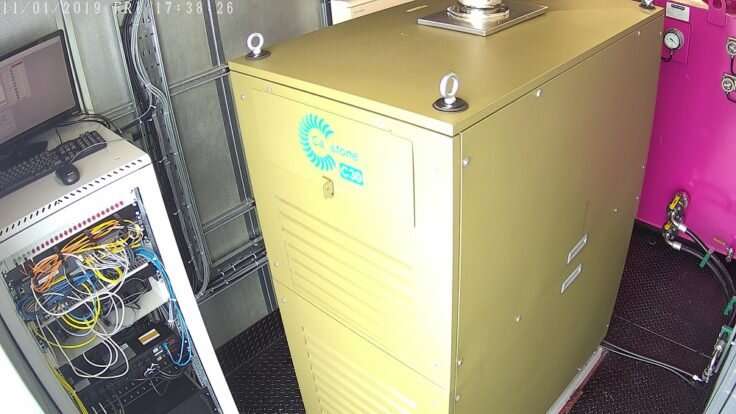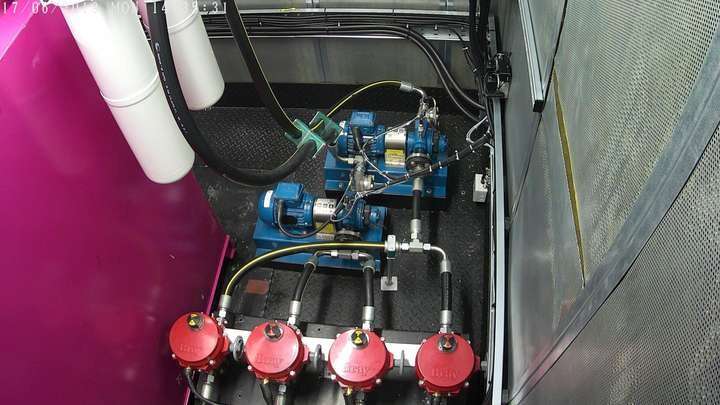The Automation platform at Halley Research Station provides power to science kit from a micro-turbine (main station in background). Credit: British Antarctic Survey
A remote and unoccupied research station in Antarctica has, for the first time, collected important scientific measurements of climate, ozone and space weather thanks to ground-breaking technology developed by British Antarctic Survey's (BAS) engineers.
The technology was developed to ensure the continuation of measurements during the winter months at Halley Research Station. The station operates currently during summer only and has been unoccupied since February this year. Operating in temperatures lower than -40⁰C an innovative power system based around a micro-turbine has collected data for 123 days.
Cracks in the Brunt Ice Shelf, on which Halley Research Station sits, have led to concerns about the stability of the Ice Shelf and the decision not to commit staff to wintering at the station until the stability of the ice shelf can be assured. The summer team who left the station on 25 February installed an innovative autonomous power system that can generate up to 30 kW of power and run a suite of scientific instruments.
The heart of the power system is a Capstone C30 Micro-turbine, similar to a jet engine, that is housed in a specially designed temperature-controlled container, with a continuous fuel and data feed. This can be controlled from BAS headquarters in Cambridge, and has provided continuous power at about 9kW since it was first turned on in January.
Thomas Barningham, Project Manager of the Halley Automation Project at British Antarctic Survey (BAS), says:
"This is the first time a micro-turbine has been used in Antarctica to power instrumentation autonomously. We are delighted that our design is working and we can collect data during the cold and dark winter months. We were confident we had a good design, but Antarctic winter conditions are brutal, so you never know exactly what might happen. So far the systems have operated in temperatures as low as—43ºC and withstood wind speeds of up to 43 knots."
David Vaughan, Director of Science at BAS says:
Engineers at BAS in Cambridge can monitor the Capstone C30 Micro-turbine daily via the web cam. Credit: Thomas Barningham
"This is a truly innovative project and the fact that it has continued faultlessly until mid-winter is a major achievement for our engineers and scientists. I'm overjoyed that the crucial programme of long-term measurement of climate, ozone and space weather are continuing today because of our engineers' skill and ingenuity. The prospect of delivering such complex science from remote locations without the requirement to have people on the ground year-round opens so many opportunities. Although it will be a while before we have a fully resilient system, my fingers are crossed that the system keeps spinning until the end of winter so we can record the formation and recovery of the annual Antarctic Ozone Hole in September to October—that would be a major triumph!"
Mike Rose, Head of Engineering at BAS, says:
"Although it's on the ice, we have approached this in a similar way to designing a satellite in space, with multiple redundant components, with large amounts of data collection and control—it's been really interesting for everyone involved.
"The major challenges for us were to maintain a continuous supply of fuel to the micro-turbine and to ensure a stable temperature inside its housing. Once we achieved the proof of concept we were thrilled to see the data coming in, and we are hopeful it will continue for the remainder of the winter."
Teams will return to Halley Research Station in November for the start of the Antarctic field season.
Take a tour of the Automation platform with our new immersive virtual reality experience here
Halley Automation facts at a glance:
The autonomous re-fuelling system was designed and built by BAS engineers. Credit: Thomas Barningham
- 81 unmanned, automatic, refuelling events to date (since last start up, 09Feb19 to 24Jun19)
- 136 days run time (since last start up, 09Feb19 to 24Jun19)
- ~30 MWhrs of electricity (since last start up, 09Feb19 to 24Jun19)
- Withstood ambient temperatures down to—43ºC
- Withstood wind speeds up to 43 knots
- Spins at 70,000 rpm day and night
- Consumes around 10% of the fuel normally burned through the same period when people are present
- Fuel consumption is approximately 6 litres per hour for the 280 days of the Antarctic winter
The full list of science equipment being automated includes:
Low Power Field Systems
- 3 x Automatic Weather Stations (Meteorology and Climate)
- 1 x Autonomous Tropospheric Ozone Monitor (Tropospheric Chemistry)
- 1 x Autonomous VLF receiver (Space Weather and Upper Atmospheric Observations)
- 1x Auto MOSAIC (Mesospheric chemistry)
- 1x LPM (Space weather)
- Entire GPS network across the Brunt Ice Shelf
Equipment powered from the micro-turbine
- AutoDobson—a fully automated version of the instrument that was responsible for discovering the hole in the ozone layer. This year represents the first year of unmanned measurements (Stratospheric Ozone Monitoring)
- A range of instruments in Halley's Electromagnetic Quiet Area that are collaboratively used globally to understand space weather and, for example, feed into global real-time lighting detection capabilities. 7x experiments, including VLF receiver, magnetometers and a Riometer (Space Weather and Upper Atmospheric Observations)
- Meteorological instrumentation monitoring local weather (e.g. cloud cover) and long term climate (Meteorology and Climate)
- 1x Tropospheric Ozone Monitor (Tropospheric Chemistry)
- 1x Halogen oxides monitor (Tropospheric Chemistry)
- Data link transferring 1GB of science and monitoring data back to Cambridge per day
Provided by British Antarctic Survey


























